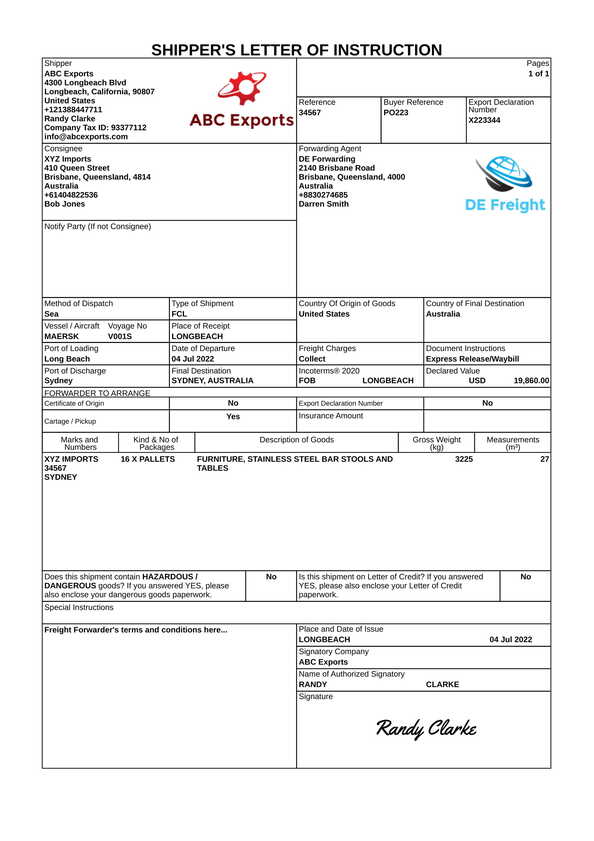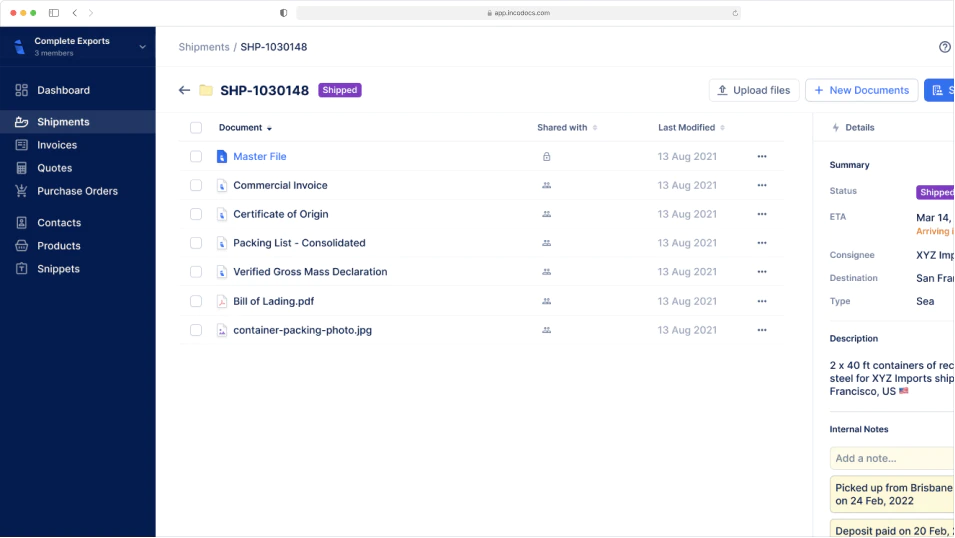IncoDocs raises $1.2M seed round led by Maersk GrowthRead the announcement

Shipper’s Letter of Instruction (SLI) Template
What is a Shipper’s Letter of Instruction (SLI) used for?
A Shipper’s Letter of Instruction is used to tell your freight forwarder how to handle your export. It includes shipper and consignee details, item descriptions, export origin, and any special handling instructions. These are instructions to ensure your shipment is processed correctly and in line with export requirements. If the forwarder is required to file data in the Automated Export System, the SLI gives them permission to do so. This helps avoid delays and keeps the process compliant.
How to create a Shipper’s Letter of Instruction (SLI)
Open IncoDocs
Open IncoDocs in your browser and navigate to the “Export Docs” section.
Choose the Shipper’s Letter of Instruction (SLI) template
Click on 'New document set' and select the Shipper’s Letter of Instruction (SLI) template along with any other export documents you wish to create.
Fill out & customize your doc
Fill out the document, customize template fields to your needs and add your company letterhead. To save time and prevent re-entry errors, enter key shipment data into the Master File to have it sync across all other documents in your set automatically.
Sign & seal
Click on the signature box at the bottom of your document to create and place a digital signature then hit “Save & Quit”. On the document preview screen, click on the ‘More’ dropdown button and select “Add company seal” to place a digital stamp.
Download or share
Download or share documents from IncoDocs in 1-click. Documents can be downloaded as PDF or CSV which can be imported into other systems without manual re-entry.
Your questions, answered.
What information is included on a Shipper’s Letter of Instruction Document?
Is SLI a legal document?
No, the SLI is not a legal contract. It is a written set of instructions that provides authorization for your freight forwarder to act on your behalf. Exporters use it to communicate how the shipment should be handled and who is responsible for filing export data. While not legally required, the SLI supports customs compliance and helps reduce confusion. It may also be paired with a Power of Attorney when Electronic Export Information (EEI) filing is needed.
Who should fill out the Shipper’s Letter of Instruction?
The exporter is responsible for completing the SLI. You’ll need to provide transportation details, shipper and consignee information, and any special handling needs. If the forwarder is required to transmit Electronic Export Information, you may also include a Power of Attorney. A clear and accurate SLI helps avoid delays and ensures the shipment meets export control rules.
Is an SLI Mandatory and Why Do I Need One?
An SLI is not legally required, but most freight forwarders will ask for it before moving your goods. It gives them the details they need to manage the shipment and file export data when needed. The SLI also helps prevent errors, supports compliance, and keeps your instructions on record. This makes the export process smoother and more reliable.
What is the difference between a Bill of Lading and a Shipper’s Letter of Instruction?
A Bill of Lading is a shipping contract and receipt issued by the carrier. It confirms the goods were loaded and outlines the terms of transport. A Shipper’s Letter of Instruction is different. It is prepared by the exporter to provide instructions to the freight forwarder, such as how to file Electronic Export Information (EEI) or handle special items. Both documents are often used together, but they serve separate roles.
Why do I need an SLI?
You need a Shipper’s Letter of Instruction (SLI) form to provide clear, detailed instructions to your freight forwarder. The SLI form helps prevent miscommunication and errors during the shipping process. It ensures regulatory compliance by including necessary export control and reporting information. Additionally, this form streamlines the documentation process, saving time and reducing the risk of delays or fines.
Free to start,
Easy to use.
Setup in 5 mins.
